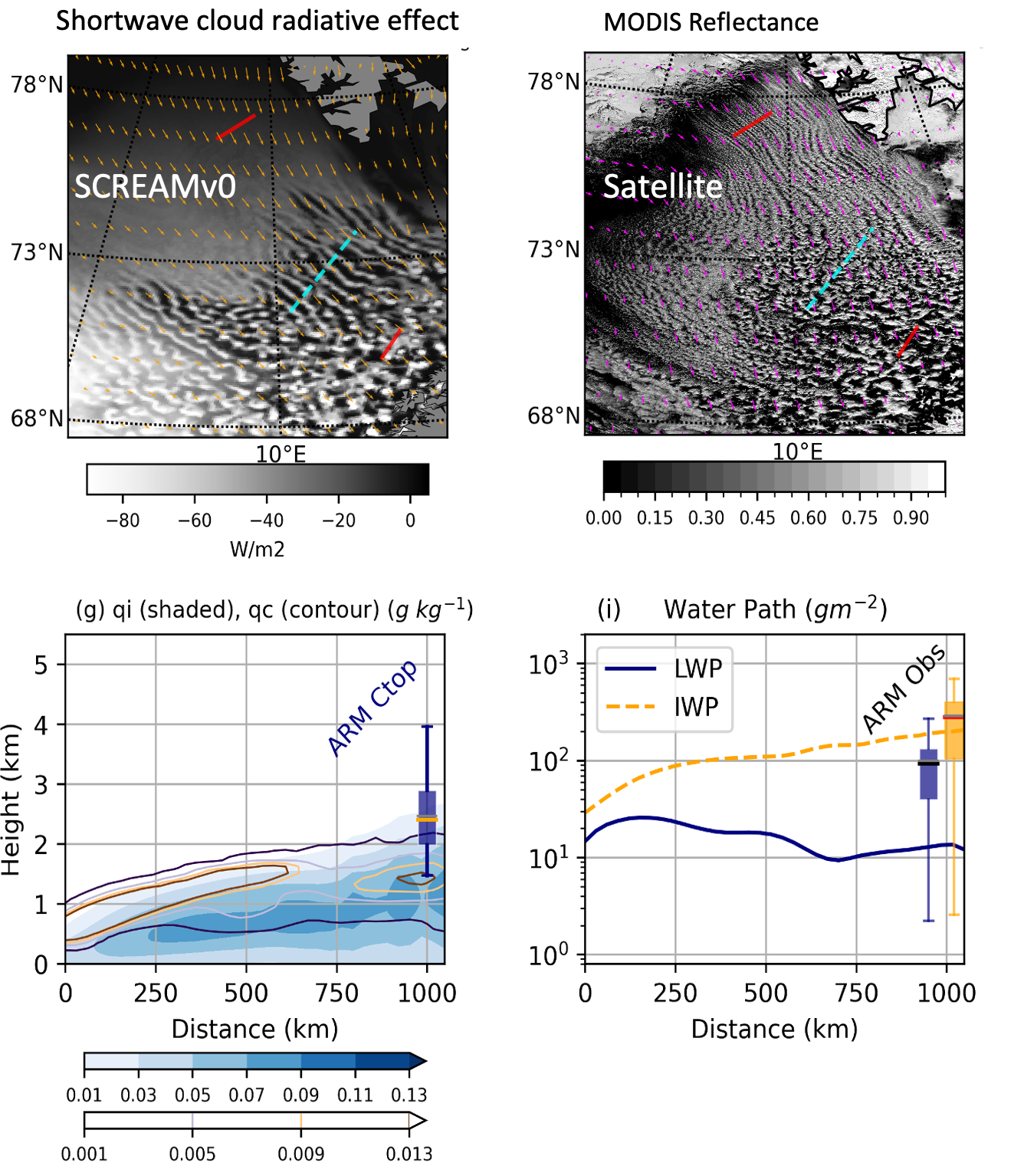SCREAM underestimates supercooled cloud liquid water
Submitter
Zhang, Yunyan — Lawrence Livermore National Laboratory
Zheng, Xue — Lawrence Livermore National Laboratory
Area of Research
Cloud Processes
Journal Reference
Zheng X, Y Zhang, S Klein, M Zhang, Z Zhang, M Deng, J Tian, C Terai, B Geerts, P Caldwell, and P Bogenschutz. 2024. "Using Satellite and ARM Observations to Evaluate Cold Air Outbreak Cloud Transitions in E3SM Global Storm‐Resolving Simulations." Geophysical Research Letters, 51(8), e2024GL109175, 10.1029/2024GL109175.
Science

Figure 1. Simple Cloud-Resolving Energy Exascale Earth System Model (E3SM) Atmosphere Model (SCREAMv0) Marine cold-air outbreaks (MCAO) event simulated on Day 34 of their debut DYAMOND2 global simulation. Upper row: snapshot of shortwave cloud radiative effect (Wm−2) at 1200UTC (12–13LST); Moderate Resolution Imaging Spectroradiometer (MODIS) reflectance on 29 March 2020 around 1100UTC. Bottom row: The vertical cross-section of daily mean (g) cloud ice condensate (shaded, gkg−1), cloud liquid condensate (contours,gkg−1) and plotted as a function of fetch from the arctic ice edge to ARM Mobile Facility site during COMBLE field campaign. The variability range of the ARM observed hourly cloud top height on 29 March 2020 is shown as navy box-whiskers. (i) Daily mean ice water path (IWP) (orange dashed) and liquid water path (LWP) (navy) (gm−2), along with the variability range of the ARM observed hourly IWP (orange box-whisker) and LWP (blue box-whisker). Box and whiskers show 25th, median, mean (gray line), 75th, 5th, and 95th percentile of the hourly observational data. Images from journal.
Cold air outbreaks (CAOs) happen when cold, dry air flows over warmer ocean areas, creating extensive boundary-layer clouds. Marine CAOs and their associated planetary boundary layer and cloud fields present challenges for numerical models, including kilometer-scale models like the U.S. Department of Energy global Simple Cloud-Resolving E3SM Atmosphere Model (SCREAM). This is because the scales of shallow convection and related mixed-phase microphysical processes are much finer than the models' effective resolution.
Impact
This study reveals that SCREAM global simulations at a 3-km resolution successfully captured three distinct cloud regimes in CAOs with realistic mesoscale structures but underestimated supercooled liquid water in mixed-phased cumulus clouds. These findings offer valuable guidance for future efforts to correct and improve biased model behaviors.
This study introduces a model evaluation method that selects observational references based on similar large-scale conditions. It uses the existing computationally expensive global simulations of SCREAM and available observations to evaluate model performance. This approach can also be applied to assessments of other cloud regimes in various regions.
Summary
This study examines the global storm-resolving model, SCREAMv0, in representing the transition of cloud morphology and cloud phase partitioning during MCAO events, using both satellite and ground-based observations from the North Atlantic during the ARM COMBLE field campaign. By selecting satellite and ARM observational references based on a combination of large-scale conditions rather than exact time-matched comparisons, this study finds that SCREAMv0 effectively captures the CAO cloud transition, including boundary-layer growth, cloud mesoscale structure, and phase partitioning. SCREAMv0 accurately identifies the greatest ice and liquid in the mesoscale updrafts but underestimates supercooled liquid water in cumulus clouds.
The model evaluation approach used in this study leverages existing computationally expensive global simulations of GSRM and available high-resolution observations to assess model performance and can be widely applied to evaluations of other cloud regimes. This practice provides valuable guidance for future efforts to develop intensive sensitivity tests on mixed-phased cloud phase partitioning and their coupling with resolved-scale motion and sub-grid scale turbulence.
Keep up with the Atmospheric Observer
Updates on ARM news, events, and opportunities delivered to your inbox
ARM User Profile
ARM welcomes users from all institutions and nations. A free ARM user account is needed to access ARM data.


















